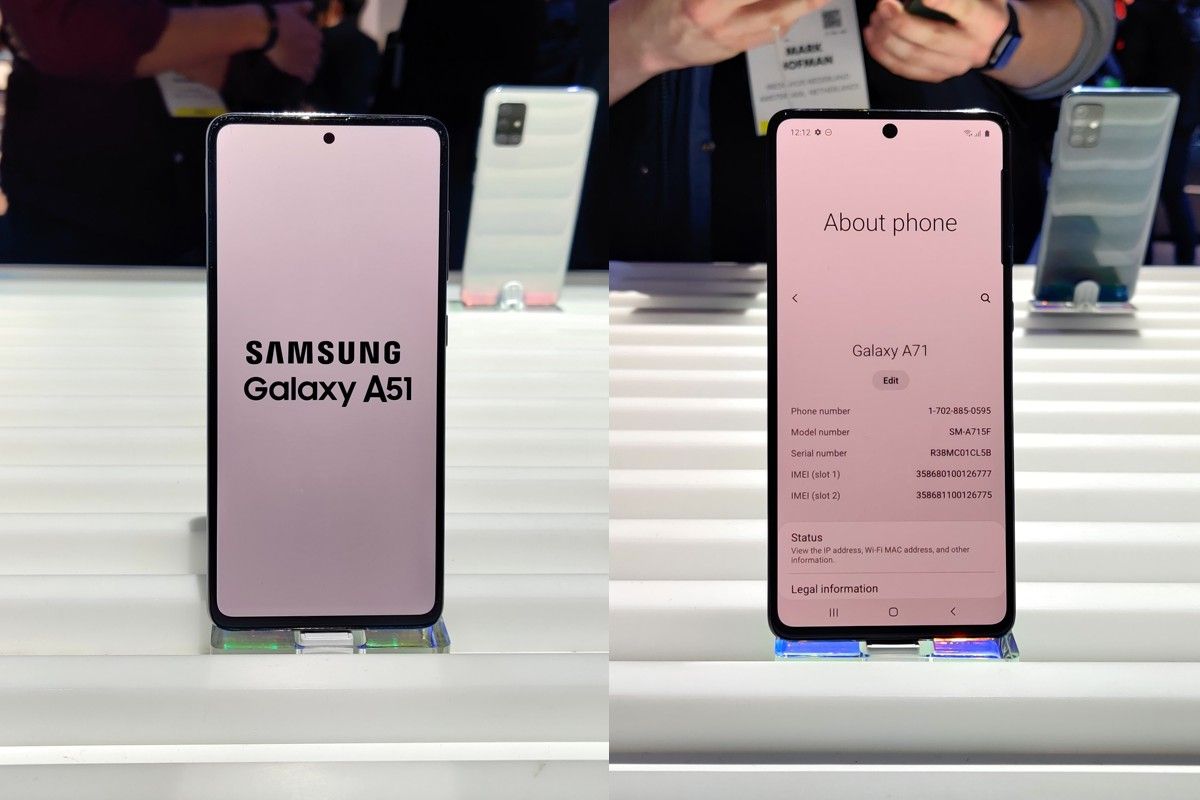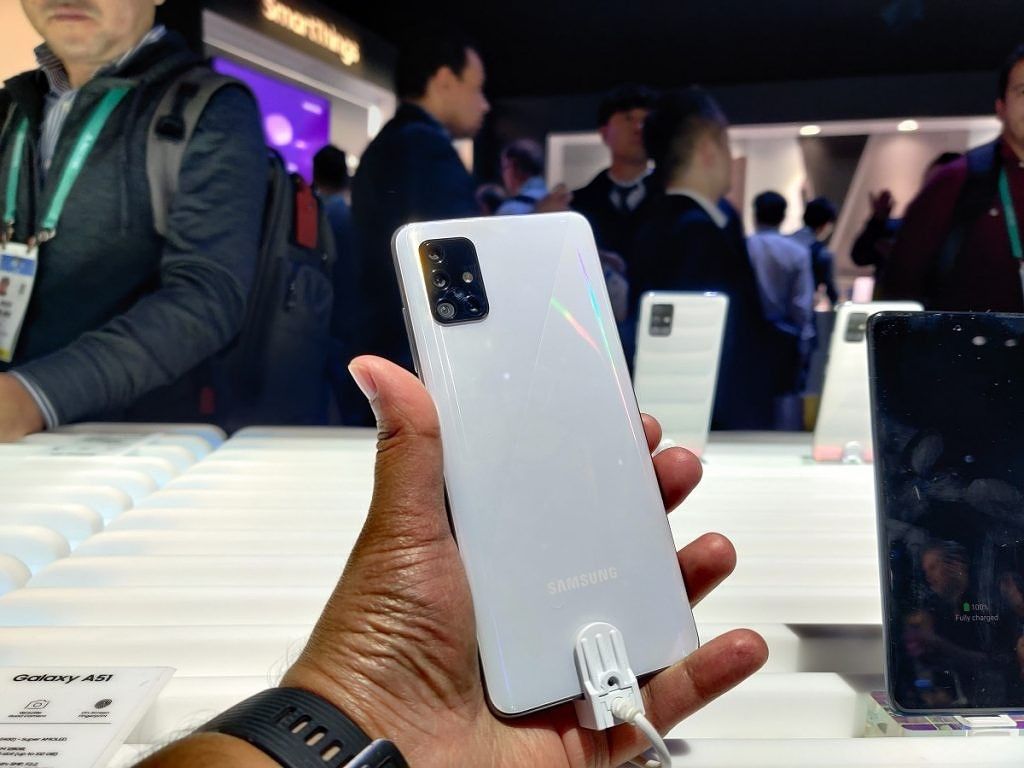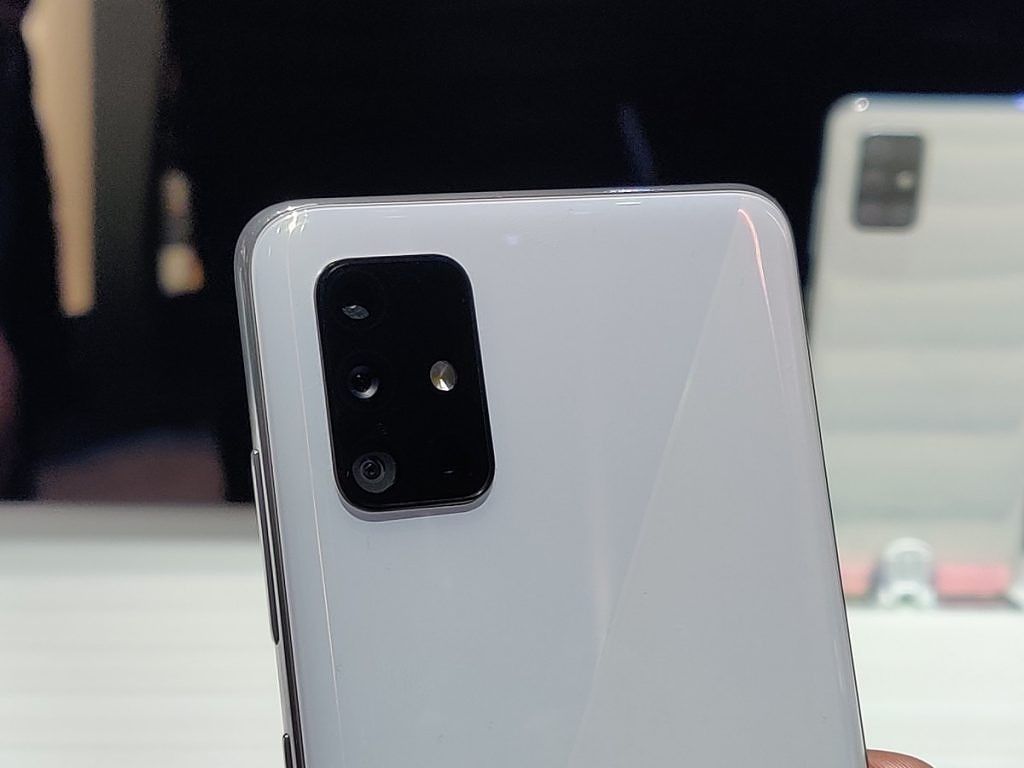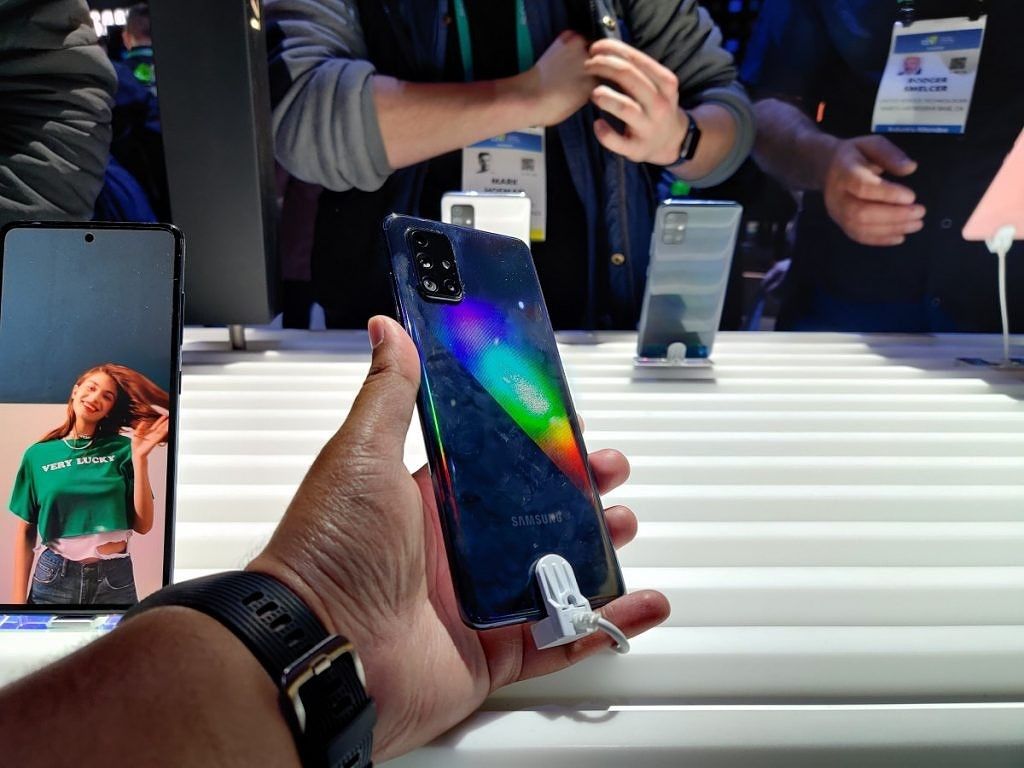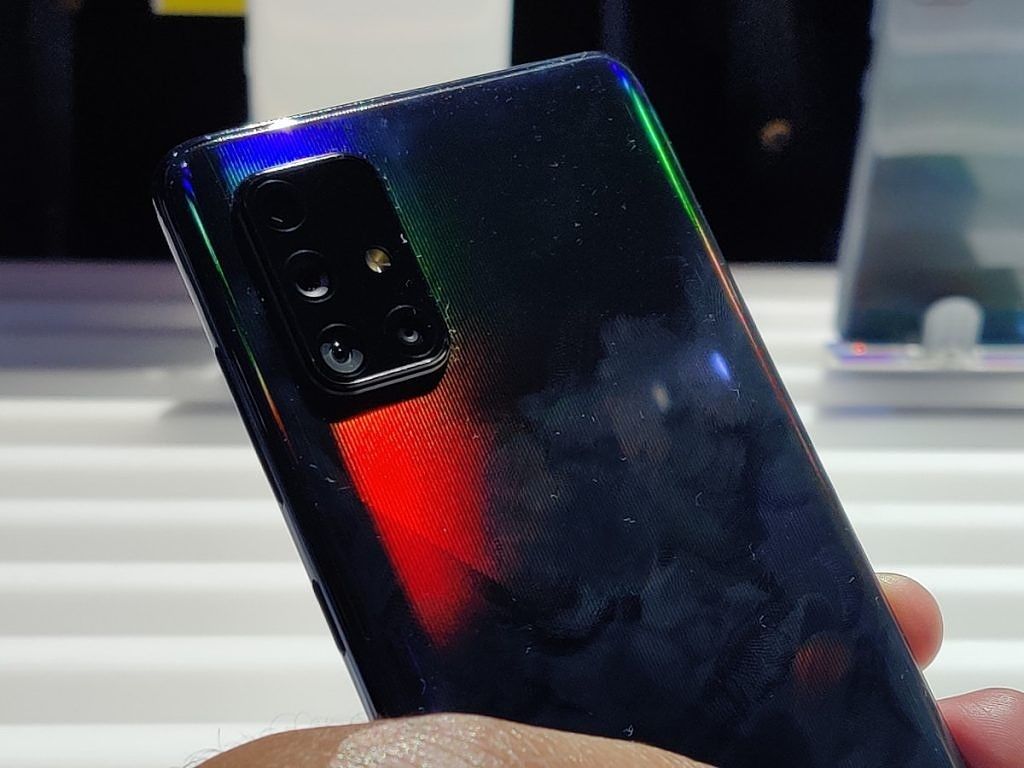Last year, Samsung managed to put out some amazing flagship smartphones. But something that often goes unmentioned is that they also doubled down in the midrange and low-end spectrum of the market. Samsung's midrange strategy, which included different smartphone lines such as the Galaxy J and Galaxy A-lines of smartphones, just wasn't cutting it anymore. That changed with the revamped Galaxy A51 and Galaxy A71.
At CES 2020 in Las Vegas, we managed to get a close look at the Galaxy A51 and the Galaxy A71, the newer-generation successors to the mid-rangers Galaxy A50 and Galaxy A70. Both the A51 and the A71 were announced a month back, yet an international release is now imminent. For everything that their low price point may imply, including lower specs and build quality, they exude Samsung's DNA by all means, featuring hole-punch AMOLED displays, multiple-camera setups, and a design language that's pretty similar, all-in-all, to what we expect to see on the upcoming Galaxy S20 flagships.
Samsung Galaxy A51
|
Specification |
Samsung Galaxy A51 |
|---|---|
|
Dimensions and Weight |
158.5 x 73.6 x 7.9 mm;172g |
|
Display |
6.5″ FHD+ (1080 x 2400) Super AMOLED;Infinity-O display |
|
SoC |
Exynos 9611 system-on-chip, octa-core processor (Quad 2.3GHz + Quad 1.7 GHz) |
|
RAM and Storage |
6GB + 128GBExpandable through dedicated microSD card slot |
|
Battery |
4,000 mAh; 15W fast charging |
|
USB |
USB Type-C |
|
Rear Camera |
48MP, f/2.0 primary + 5MP, f/2.2 depth sensor + 5MP, f/2.4 macro + 12MP, f/2.2 ultra-wide |
|
Front Camera |
32MP, f/2.2 |
The Galaxy A51 is, evidently, the lower-end one out of the two, yet in the hand, it feels just as premium as the Galaxy A71 does. Just like its predecessor, the Galaxy A50 and the Galaxy A50s, the Galaxy A51 comes in a plastic body, with a plastic frame as well as a shiny plastic back. And talking about the back, it is probably the most noteworthy design feature of the device. It has a gradient finish (with the white variant in particular, which is the one we handled, being pretty reminiscent of the Galaxy Note 10's Aura Glow color option with rainbow-ish reflections and shades), and the back has a polygonal effect with an X-shape, which really helps highlight this rainbow effect even further. Samsung calls this effect "Prism Crush", a tagline which is also present in all color options the device is going on sale with.
The Galaxy A50s, which served as a revision to the Galaxy A50, also featured a similar polygonal effect, and it's really eye-grabbing---even more so in person. The phone feels fairly light in the hand, which is probably helped by the device's plastic build, and despite its 6.5-inch display, it doesn't feel very big either.
Right by the top-left corner, there's the rear quad camera setup which, in tandem with Samsung's new design language for 2020, is housed in a square-shaped module, reminiscent of other smartphones such as the Google Pixel 4 and the iPhone 11/11 Pro/11 Pro Max. Recently launched Samsung devices such as the Galaxy S10 Lite and the Galaxy Note 10 Lite also feature such a square-shaped module, and the Galaxy S20 lineup is also expected to feature something like this. This camera setup, in particular, features a 48MP main sensor coupled with a 5MP depth sensor, a 5MP macro sensor, and a 12MP ultra-wide camera, so it's set to be a very versatile camera module.
The phone also features a headphone jack by the bottom, which is a feature Samsung started to do away with, unfortunately, with the Galaxy Note 10. We're glad to see them keeping it, even if it's just in their midrange phones. The left side of the phone houses the SIM card/SD card tray while the right side features the power button and the volume rocker.
Going to the front, it's dominated by a 6.5-inch Super AMOLED display with a hole-punch camera, seemingly smaller than what the Note 10 lineup had, and featuring a 2400x1080 resolution with a 20:9 aspect ratio. The hole punch camera, which is centered, just like the one in the Galaxy Note 10, instead of in the corner, is a 32MP camera sensor that should be able to provide you very decent selfies, and the display itself is definitely the quality that you would expect from a Samsung panel in recent times. The fingerprint sensor, just like its predecessor, is embedded into the display.
As for other features, there is also a 4,000 mAh battery which should provide you usable battery life to get through your day. There's also up to 6 GB of RAM and up to 128 GB of storage---expandable, in case that's not enough for you. The device is running Android 10 out of the box with One UI 2.0 on top, showing, again, Samsung's renewed commitment to software.
Samsung Galaxy A71
|
Specification |
Samsung Galaxy A71 |
|---|---|
|
Dimensions and Weight |
163.6 x 76.0 x 7.7 mm;179g |
|
Display |
6.7″ FHD+ (1080 x 2400) Super AMOLED;Infinity-O display |
|
SoC |
Qualcomm Snapdragon 730 system-on-chip, octa-core processor (Dual 2.2GHz + Hexa 1.8 GHz) |
|
RAM and Storage |
6GB/8GB + 128GBExpandable through dedicated microSD card slot |
|
Battery |
4,500 mAh; 25W fast charging |
|
USB |
USB Type-C |
|
Rear Camera |
64MP, f/1.8 primary + 5MP, f/2.2 depth sensor + 5MP, f/2.4 macro + 12MP, f/2.2 ultra-wide |
|
Front Camera |
32MP, f/2.2 |
The Galaxy A71 is, for the most part, very similar to the Galaxy A51. Obviously, it's supposed to be higher-end, although, at least in my opinion, there are more similarities than differences. It's bigger, yes---it features a 6.7-inch panel instead of a 6.5-inch one like the Galaxy A51, and because of this, it has a bigger footprint, although not that much bigger despite what it may initially look like. What's bigger, too, is the hole punch at the top of the display. Just like the A51, it's centered, yet it's slightly bigger. It has the same 32MP front-facing camera, so there's no reason why it should be bigger, yet it is. It definitely does not look bad, though.
Going to the back, the same "Prism Crush" multicolor effect is present in this unit, although the polygonal effect is definitely not as pronounced. The camera hump in the top left corner looks the exact same as the one in the Galaxy A51 and the camera setup itself is pretty similar as well---almost identical, in fact. The only difference between the two is that the Galaxy A71 carries a 64MP main sensor---just like the Galaxy A70s---instead of the Galaxy A51's 48MP main sensor. Both devices look as outstanding in person as they look in renders.
Again, going to the front, it is almost entirely dominated by the display with very, very small bezels to be seen. The punch-hole, again, is more prominent than what we saw in the lower-end variant, yet it's a similar size to the Note 10, so again, far from something to worry about. The fingerprint sensor is embedded under the display, and unlike the higher-end Samsung Galaxy S10/Note 10 phones, they feature an optical fingerprint scanner instead of an ultrasonic one. Both optical and ultrasonic sensors have their pros and cons and I wouldn't call one superior to the other, so this really comes down to a matter of taste. Optical sensors usually come with cheaper phones, though.
Internally, the phone features a 4,500 mAh battery (up from the 4,000 mAh one in the Galaxy A51) and carries a Qualcomm Snapdragon 730 processor, up to 8 GB of RAM and up to 128 GB of internal storage which, yes, you can expand with a microSD card to fit your needs. The device is running Android 10 out of the box with One UI 2.0 on top, just like the A51, which is great to see as it means that both devices will get updates to, at least, Android 11 and Android 12 down the road.

